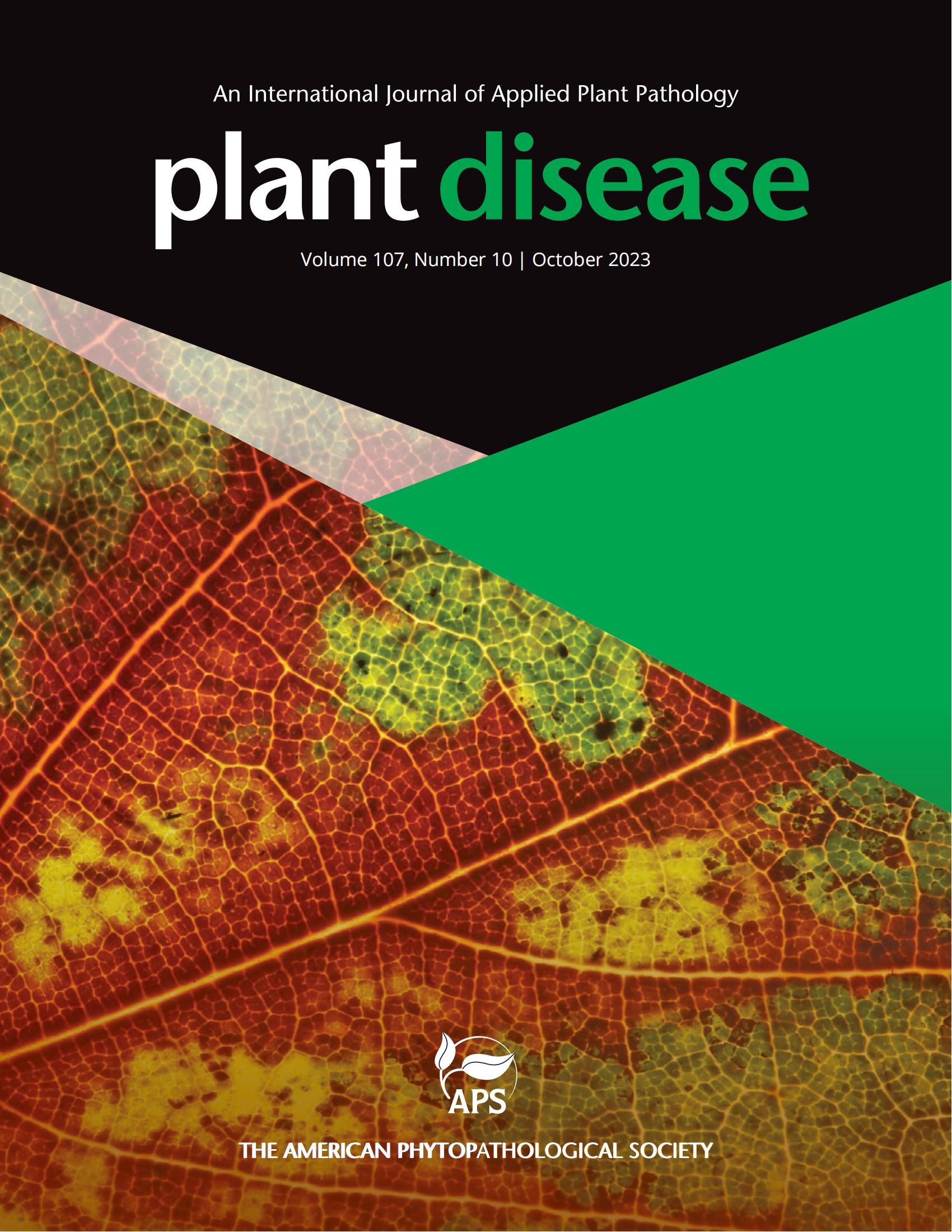中国番茄枯萎病报告初报。
摘要
2024年5月,山东省潍坊市某番茄田(36°54′6.876”N, 118°51′17.003”E)发现枯萎病,发病率约为32%。该疾病的典型症状包括叶片萎蔫和茎一侧的浅棕色或脏白色细长病变。收集3株病株,标记为FQKW24-1-FQKW24-3。将有病变的茎组织切成5mm的小块,75%乙醇表面消毒45 s, 3% NaClO表面消毒1 min。用无菌蒸馏水三次冲洗后,将组织转移到马铃薯葡萄糖琼脂(PDA)上,25℃黑暗培养5天。采用菌丝尖端法(Leslie and Summerell, 2006)分离得到9株菌落形态一致的分离菌株。选取具有代表性的菌株FQKW24-1A和FQKW24-2A进行形态鉴定。菌落呈白色或淡色的葡萄状中心,具有絮状结构和丰富的气生菌丝。中心呈反白色或淡葡萄色,缺乏可扩散的色素。FQKW24-1A和FQKW24-2A在合成营养不良琼脂(SNA)上的微分生孢子呈椭圆形至镰形,尺寸分别为7.3 ~ 13.7 (x′=10.1)× 2.7 ~ 4.7 (x′=3.7)μm和8.9 ~ 18.7(x′=13.0)×3.3 ~ 5.9 (x′=4.6)μm。在香石竹叶琼脂(CLA)上,大分生孢子为镰刀形,3 ~ 5隔,33.9 ~ 50.4 (x ā =41.6) × 5.6 ~ 3.2 μm (x ā =4)。FQKW24-1A和FQKW24-2A分别为35.5 ~ 57.7 (x ā =44.7)和3.6 ~ 5.8 (x ā =4.8) μm。Wang et al.(2019)扩增了翻译延伸因子1- α基因(tef1)、钙调素(cmdA)和RNA聚合酶II第二大亚基(rpb2)。分离株FQKW24-1A、FQKW24-2A和FQKW24-3A的tef1、cmdA和rpb2序列(PV018785-PV018793)已提交GenBank。序列比对结果显示,tef1、rpb2和cmdA分别与F. nirenbergiae CBS 840.88前型培养物的相似性为99.8%(614/615)、99.4%(871/876)和99.8%(601/602)。利用PhyloSuite软件结合cmdA、tef1和rpb2序列进行系统发育推断,3个分离株与尼伦伯格菌属聚在一个分支。根据形态和系统发育分析,分离株鉴定为尼伦伯格菌。在人工气候箱中(25℃,RH 80%,光周期12 h)对盆栽15-20 cm的番茄幼苗进行2次致病性试验。植株在无菌土壤中生长,分别接种20 ml(106个分生孢子/ml)的nirenbergiae孢子悬浮液。对照植株用水模拟接种。每个处理包含10株植物。接种后20 d出现第一次症状,表现为叶片从下向上脱落,呈特征性黄萎蔫。在3个月内,接种植株的茎组织表现出与田间观察相似的典型症状。对照组保持健康。为了实现Koch的假设,从有症状的植物中重新分离的真菌通过TEF序列确认为F. nirenbergiae。F. nirenbergiae在美国和荷兰导致番茄枯萎(Lombard, et al. 2019),在意大利导致百香果枯萎(Aiello, et al. 2021),在中国导致土豆/藏红花腐烂(Li et al. 2025;Mirghasempour et al. 2022)。据我们所知,这是中国首次报道尼伦伯格菌引起番茄枯萎病。这些发现有助于制定尼伦伯格菌番茄感染的控制策略。In May 2024, Fusarium wilt was observed in a tomato field in Weifang City, Shandong Province (36°54'6.876" N, 118°51'17.003" E) with an incidence of approximately 32%. The typical symptoms of the disease included leaf wilting and light brown or dirty white elongated lesions on one side of the stem. Three diseased plants were collected and labeled as FQKW24-1-FQKW24-3. Stem tissues with lesions were cut into 5 mm pieces and then surface sterilized with 75% ethanol for 45 s and 3% NaClO for 1 min. After triple rinsing with sterile distilled water, the tissue were transferred on potato dextrose agar (PDA) and incubated in darkness at 25°C for 5 days. After purification using hyphal-tip method (Leslie and Summerell. 2006), 9 isolates with consistent colony morphology were obtained. The representative strains FQKW24-1A and FQKW24-2A were selected for morphological identification. The colonies exhibited white or pale vinaceous center, with a floccose texture and abundant aerial mycelium. Reverse white or pale vinaceous in the center, lacking diffusible pigment. Microconidia on synthetic nutrient poor agar (SNA) were ellipsoidal to falcate, measuring 7.3 - 13.7 (x̄=10.1) × 2.7 - 4.7 (x̄=3.7) μm and 8.9 - 18.7(x̄=13.0) ×3.3 - 5.9 (x̄=4.6) μm for FQKW24-1A and FQKW24-2A, respectively. On carnation leaf agar (CLA), macroconidia were falcate, 3-5 septate, 33.9-50.4 (x̄=41.6) × 5.6 - 3.2 μm (x̄=4. 6) and 35.5 - 57.7 (x̄=44.7) × 3.6 - 5.8 (x̄=4.8) μm for FQKW24-1A and FQKW24-2A, respectively. The translation elongation factor 1-alpha gene (tef1), calmodulin (cmdA), and RNA polymerase II second largest subunit (rpb2) were amplified according to Wang et al. (2019). Sequences of tef1, cmdA, and rpb2 (PV018785-PV018793) of the isolates FQKW24-1A, FQKW24-2A and FQKW24-3A were submitted to GenBank. Alignment analysis of these sequences revealed similarities of 99.8% (614/615), 99.4% (871/876) and 99.8% (601/602) with the ex-type culture of F. nirenbergiae CBS 840.88 for tef1, rpb2 and cmdA, respectively. Phylogeny inferred based on the combined cmdA, tef1 and rpb2 sequences using PhyloSuite software, showed the three isolates and F. nirenbergiae were clustered into one branch. Based on morphology and phylogenetic analyses, the isolates were identified as F. nirenbergiae. Pathogenicity tests were conducted twice in an artificial climate box (12-h photoperiod at 25 °C, RH 80%) on 15-20 cm tomatoes seedlings with the pot culture. Plants were grown in sterilized soil and separately inoculated in pots with 20 ml of F. nirenbergiae spore suspension (106 conidia/ml). Control plants were mock-inoculated with water. Each treatment contained 10 plants. The first symptoms appeared 20 days after inoculation, which were a characteristic yellowing and wilting of foliage, falling off from bottom to upward. Within 3 months, stem tissues of the inoculated plants exhibited typical symptoms similar to those observed in the field. The controls remained healthy. To fulfill Koch's postulates, fungi reisolated from symptomatic plants were confirmed as F. nirenbergiae by TEF sequences. F. nirenbergiae causes tomato wilt in the United States and the Netherlands (Lombard, et al. 2019), passion fruit wilt in Italy (Aiello, et al. 2021) and potato/saffron rot in China (Li et al. 2025; Mirghasempour et al. 2022). To our knowledge, this is the first report of F. nirenbergiae causing wilt of tomato in China. These findings aid in developing control strategies for F. nirenbergiae tomato infections.

 求助内容:
求助内容: 应助结果提醒方式:
应助结果提醒方式:


